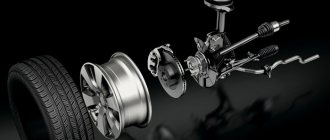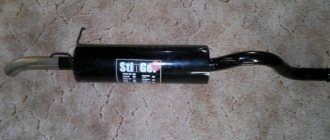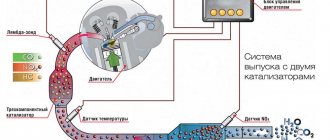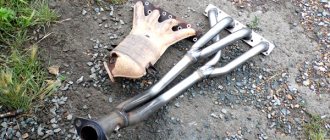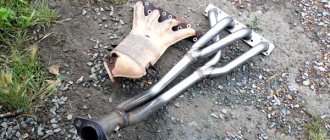- home
- Car muffler
- …
It's no secret that the internal combustion engine has a very low efficiency (gasoline is around 25%, diesel can be pumped up to 40 - 50%). There’s nothing to be done, but these motors are essentially last century (I think electric cars are just around the corner). The matter can be corrected with all sorts of modifications, for example, installing a turbine, lightening the design of the pistons, crankshaft, etc. Refinement of intake and exhaust systems. This is exactly the issue that many tuners are currently struggling with, because in the right hands you can actually remove up to 10% of the power. But how does this happen? Some people think that it is enough to install the so-called “spider” according to the formula 4-2-1 or 4-1 and that’s ALL! BUT what is this anyway? What spiders, what formulas - what it gives and how it is configured. Read on and you will understand everything...
Let's start with the fact that any engine has an intake and exhaust manifold . It is clear that the fuel mixture (air + gasoline) enters through the “intake”, and exhaust gases (burned in the combustion chamber) leave through the “exhaust”. So, if you make the exhaust system as unobstructed as possible, you can achieve a slight increase in power.
What is the problem with release anyway?
There are only two problems:
- This is noise . That's why the exhaust system is often called a muffler to dampen loud sounds.
- This is ecology . Not all gases burn in the combustion chamber, and to put it in “simple language” they need to be “burned or decomposed” into more or less safe components, this is done by the catalyst .
If there were no muffler, the engine power would be approximately 10% more by default (depending on the valve and camshaft settings). BUT it would be impossible to drive such a car, firstly, you yourself would become deaf from the crackling sound that escapes from the engine (and you would be fined for disturbing the peace of citizens, this is now punishable by law), and secondly, the environmental component would be worse zero, because there is no catalyst (and we already have a polluted world that requires global cleaning) - it is not possible to pass MOT with such an indicator, and even now traffic police officers can easily check the exhaust.
In general, the gas muffling system CANNOT be removed, but it can be improved, which is exactly what tuners do.
Replacement on a 16-valve engine
In the case of a 16-valve power unit, the catalyst is included in the design with the output manifold. Therefore, look for it behind the cylinder block directly in the engine compartment.
The nuance of dismantling the 16-valve engine is the presence of two lambdas.
- The first is located directly on the catalyst. It serves to adjust the fuel mixture;
- The second is located on the flange after the device. It is called ecological. If this lambda is not in place, the sensor will immediately generate an error, the injection will stop working properly, thrust will increase and fuel consumption will increase.
There are two ways to solve this issue:
- If you bought a spider for one regulator, the electronic control unit can be upgraded to Euro 2 from the current Euro 3. But such a spider has a serious drawback - the only thread for the lambda is on the flange. To mount the injection lambda there, you will have to assemble an extension cord from a wire and two connectors, called mother-father.
- If it is a spider with two regulators, the injection lambda is mounted in a standard socket. The thread for the second sensor is plugged or a dummy for the electronic control unit is installed in its place. In the second situation, there is no need to reflash the ECU.
What is a spider in a car?
Yes indeed - what is it?
Actually, everything is also simple here - this is the exhaust tract (manifold) which is attached to the engine block and removes exhaust gases .
By the way, our grandfathers and fathers called it “pants” (because they are somewhat similar to them). Tuners now call it a “spider” (it looks like this insect because of the plexus of pipes), especially not the standard one, but the one that has been modified according to certain formulas - dimensions - calculations (for example, 4-2-1, 4-1, etc. ., more on that a little later).
There are a lot of names, but the essence is the same. I read somewhere that this name was made to attract the attention of young people, marketing and all things, the more aggressive you call it + 10 horsepower!
Open the interpreter
The sign “spider in the house” has many interpretations. So the ancestors were sure that seeing small arthropods would bring prosperity and good luck. The only negative point in all the predictions is that the representative of the spider world lowers
It doesn’t matter here: where, when they saw the creeping creature. It’s much worse if there are no them in the house at all.
There is so much negativity in the room that spiders cannot remove them, which makes it impossible to have a comfortable stay. This means they leave their home. If you notice an insect in a corner, on a wall, on the floor, do not be alarmed, but take a closer look at its movements and appearance. This is the only way to make a prediction for yourself and your loved ones.
Common signs about spiders
Small legs, big body - the sign “a spider in the house” indicates material wealth. You can safely begin the renovation. Getting ready for vacation. Provided that the creature stands still or crawls up. An insect with long legs and a big small body - there will be money in the house, but don’t expect enough money to buy a car, European-quality renovation, or a trip to the sea. There will be money in the family, but not in excess.
There are a lot of cobwebs on the walls and in the corners: the sign of a spider in a home serves as an indicator of urgent cleaning of the house. To do this, removing the spider web is not enough. They wash the walls, furniture, windows, dishes - everything in the room with the addition of holy water to the general liquid. After cleaning, cross the corners and walk clockwise around the apartment. During cleaning, only the wickerwork is removed, but the sign of “killing the spider” is valid - loss of wealth, the keeper of the hearth.
The color of the insect is also important. The lighter the better. But you shouldn’t be afraid of dark, black people either. The sign “spider in the corner” indicates high-quality protection of the family from negativity, damage, and the evil eye. It’s also an excellent barometer: hiding means it’s going to rain, working actively means the sun is guaranteed in the sky.
On the floor and bathroom
Seeing a spider is a great omen. Only on the condition that the insect did not settle in the bathroom. The interpretation changes are cardinal:
- behavior needs to be rethought;
- change life positions;
- stagnation in business;
- problems in personal life;
- money flows into the unknown.
But unexpectedly seeing a spider in the bathroom means a profit that was not expected. If at this moment you are afraid, the sign “spider at home” promises unpleasant news, bad news. If you notice a guest on the floor, expect changes. But carefully observe for 2-5 seconds where the visitor goes. Moving away means loss, getting closer means profit.
The sign of a “spider on a web” anywhere in a living space makes it possible to make a wish. We saw it, we made a wish, we carefully monitor the answer: up - it will come true, down - the answer is negative. Also, noticing a flycatcher weaving a web is a harbinger of prosperity. The location doesn't matter. We saw it. They asked us to weave strong nets for good luck. Now, fearlessly take on risky ventures related to money.
On the wall
Signs associated with a spider seen on the ceiling or wall have a different interpretation. The higher it sits, the more profitable it is for the owner. A spider on the ceiling brings omen, especially if it has fallen, only good news, a large inheritance, material wealth. A person was working, doing household chores, and the “neighbor” drops in front of his face? Then expect pleasant surprises, new profitable acquaintances, news with positive aspects. A sharp change in direction means that everything good will be overshadowed by trouble. Perhaps someone will jinx it, steal, or deceive.
Meeting time
Seeing a spider in the evening is definitely a wonderful, and most importantly, profitable omen. Expect pleasant, positive changes in your personal life and career growth. Problems go away and things return to normal. The sign “a spider is crawling down” in the evening is a warning. Thoughtless spending of money is a financial ruin. You can bring problems of the material plane.
The sign “spider at night” means quick financial stability. But you can’t tell anyone about success. Judge your profit and career by size. The larger the body, the more significant the support of fortune.
In the morning we noticed a spider crawling - a positively charged sign. Portends success and good luck in all areas of life. But keep track, do not forget about the direction chosen by the insect.
If you get caught in a web, you should ward off trouble and trouble. Say “Cheer me.” Such a ritual helps to get rid of negativity and troubles if done right away. Applies to any sign of a “spider in the house”
It is especially important to remember: killing an insect on purpose is prohibited. You will attract troubles and misfortunes
Standard "glushak" - what's bad?
Actually, we’re starting to get to the most interesting part, what’s wrong with the standard system? Why does it urgently need to be replaced (I think all tuners do this)?
The answer is simple - the standard system, it can be called 4-1 - UNDEVELOPED!
To begin with, what is formula 4-1 - these are four pipes (from each cylinder) that are connected at one point (pipe) and then the whole thing goes into the main path through the catalyst, resonators, etc.
NOW WHY IS SHE NOT DEVELOPED? As a rule, to please engineers, environmentalists and others, the manufacturer makes short pipes from the engine cylinders, which are immediately connected into one. Why is this bad? YES because the distance to neighboring pipes is very short. During exhaust, a certain wave is formed, which should remove gases into the main exhaust - BUT this wave also enters adjacent pipes and cylinders, thereby inhibiting the removal of gases. The situation is aggravated by the presence of a catalyst (because it is a filter and creates additional resistance), the presence of advanced resonators (sound is damped well, but gas removal is worse) and the diameter of the pipe (often made thin, within reason of course).
To put it in simple words, the engine seems to be strangling itself , that is, this is the UNDEVELOPMENT of the gas exhaust system. The engine must “breathe” (discharge waste freely), thereby increasing the power.
First signs of trouble
- The dynamics of the car have deteriorated significantly.
- The engine is difficult to start.
- There is a sulfur smell inside the car.
- At idle, the engine is unstable.
If you feel that the car has become worse, you should first check the catalyst. But, unfortunately, this is not easy to do at home, since you will need special equipment for diagnostics. Still, there are a couple of ways to check.
Checking with a pressure gauge
Method one. A pressure gauge should be screwed into the place where the lambda probe is installed. Then start the engine and see what pressure is in the exhaust system. If it exceeds 0.5 atmospheres, this is the first sign that the catalyst is faulty.
Pyrometer
Method two. In this case, you need to use a remote pyrometer and check the temperature before and after the catalyst. If the device is faulty, the temperature before and after the catalyst will be the same. This means that the internal honeycombs are destroyed and the flame suppression function is impaired. In this case, the catalyst must be replaced with a VAZ 2114. If the device is working properly, then the temperature before it will be an order of magnitude higher than after it. Depending on what power unit is installed on the car, eight or sixteen valves, replacing the catalyst has its own nuances.
Learn more about verification methods in this video:
SPIDER 4-2-1
How does it work and what does it give? Again, it’s very simple - the short pipes that come from the engine are extended (in theory they should be about two meters, but this cannot be realized physically), they are connected in pairs - that is, two pipes, say, from the first and fourth, and two from the second and the third (along the parallelism of the exhaust), after which these pairs are connected into one pipe (but already far from the block).
It turns out 4 outputs - 2 pairs (2 pipes each) - 1 common at the end. So much for the 4-2-1 formula.
Thus, there is no longer a close connection between the outlet channels, the gases do not interfere with each other (they are grouped) and are discharged more confidently. Thus, the spider gives an increase in power.
Some features
There are several nuances that should be taken into account when modifying the exhaust system of a VAZ-2114. The installed tuning manifold is wider in size, so it will touch the rubber pipe leading to the stove. To prevent this from leading to coolant leakage in the future, this pipe should be replaced with a new, longer one, and taken away from the manifold.
The lambda probe will also have to be replaced, since the hole for its mounting in the tuning manifold is lower than in the standard one, which is why this sensor with extended wiring is needed.
Also, the “Spider” is more voluminous at the bottom, so installing underbody protection is no longer possible.
The final stage of all this work is reflashing the electronic control unit, which will allow the new exhaust system to be “perceived” as standard. Also, flashing will allow you to “unleash” the full potential of the power plant after processing. It is better to perform flashing from knowledgeable specialists at a service station.
This is all the work related to the processing of the exhaust system of the VAZ-2114 car.
SPIDER 4-1
The principle here is the same, the cylinders do not interfere with each other to discharge “working off”. Only the formula is a little different. There are 4 long taps from the engine block, which connect into one large path far behind the block.
It turns out 4 extended outputs - in one path (far from the block), there is no parasitic resistance. Here's the 4-1 formula
Such a spider should also work well. However, as usual, there is one BUT.
Operating principle of the exhaust manifold
The movement of gases through the exhaust channels is a wave process, which they experimentally try to reconcile with the wave processes that arise when the fuel mixture moves in the suction tract. The opening of the exhaust valve causes gas under pressure to flow from the combustion chamber into the exhaust manifold. In this case, the pressure difference in these two cavities leads to the formation of a wave, which is reflected from nearby obstacles (for example, a catalyst), is directed back to the cylinder and reaches it at the time of the next exhaust stroke. Such a sharp removal of combustion products leads to the formation of a vacuum in the cylinder, which improves the cleaning of the cylinder itself and more quickly fills it with fresh combustible mixture. The wave propagates at the speed of exit from the cylinder, so the resulting resonance is formed in the pipe in a fairly wide range of revolutions. Consequently, an increase in engine speed leads to an acceleration of the exit of gases from the cylinder and an acceleration of the movement of the wave, which just manages to return to the beginning of the next, shorter cycle.
Spider Efficiency
There are a lot of companies on the Internet that say almost the same thing, put a spider on your VAZ and the power will immediately increase by 10% - WOW! That is, it was 100 hp. and then it’s 110 right away, and I’ll tell you this is noticeable!
BUT IS THIS REALLY SO? Let's understand it logically:
- Installation requires removal of the catalyst. And it has already been proven that removing this filter adds 4 to 5% power
- You need to flash it for EURO 2 - 3. Otherwise, there is no filter element! But with firmware you can catch up your car to 7 - 10% power
- Other resonators are installed. Sports as they are called! They have less resistance by another + 2-3%
- Sometimes this entire system is made from a larger pipe with a diameter of 51 mm.
SO what does the spider itself do and is it really +10%? Most likely no! YES, it gives a small increase, about 2-3% on its own (but you won’t be able to feel them, because this is at the error level). YES, and this performance OFTEN happens only in a limited range of work, for example 5000 - 6000 rpm (not always, but OFTEN). YOU need to understand that if you are planning to install it, then you need to do it in conjunction with other operations, otherwise the effect will be almost undetectable.
Now we are watching the video version.
This is where I end, subscribe to our channel and website - there will be many more interesting articles and videos. Sincerely yours, AUTOBLOGGER.
Similar news
- Catalyst service life. When should it be changed?
- Water in the muffler. Reasons, how to get rid of it and whether it can be drilled
- Removing the catalyst. Pros and cons, consumption, firmware - revealed...
Add a comment Cancel reply
Where was it found?
Fate itself gives you an encrypted signal:
- sat directly on the mirror - quick news from a near and dear person, it is possible to receive a letter, SMS, phone call:
- on things left in the cabin - you risk getting into an accident, or even parting with your favorite car.
The spider spun a web in the car
Our ancestors also considered the spider net to be a home talisman. Being the helpers of a good brownie, spiders used it to catch evil spirits who promised trouble and failure in business, and scared away evil spirits and unkind envious people who perpetrated all sorts of intrigues, causing the evil eye and damage. All this is automatically transferred to the car, because in a sense it also serves as our home.
Did you see a spider inside the cabin, and besides, it had already managed to weave a web? Don't rush to kick him out of there. Fate itself sent you this amulet. With such a “passenger”, any troubles will bypass your car. Be it technical malfunctions, traffic accidents, illegal penalties.
Many car owners are sure that a cobweb will become a reliable trap, promising happiness on a long journey. Do not tear it down and your car will be fully protected.
See a spider on the driver's mirror of a car
Have you noticed a small alien on one of the side mirrors or for your rear view? No need to casually brush it away.
Since the spider has chosen this place, expect good news. Guests will soon come to you, and maybe news will arrive from distant relatives or close friends.
Spider lives in the car
Did you see that a permanent resident appeared in the car? This is a joyful event. Reliable protection of this property is guaranteed. It will protect your pet from unpleasant incidents, eliminate conflicts, prevent financial losses due to fines, and become a good patron for all members of your family.
But there is some danger that the omen will turn back on you.
Spider in the trunk
The reason may be trivial - apparently, you have not used this utility compartment for a long time. If this is not the case and the luggage compartment is constantly in use, expect a quick improvement in your material wealth.
Product delivery options
Note! Below are the shipping methods available specifically for this product. Payment options may vary depending on the shipping method. Detailed information can be found on the “Delivery and Payment” page.
Parcel by Russian Post
Available payment methods:
- Cash on delivery (payment upon receipt)
- Using cards Sberbank, VTB, Post Bank, Tinkoff
- Yandex money
- QIWI
- ROBOKASSA
Shipping throughout Russia. Delivery time is from 5 to 12 days.
Parcel by Russian Post 1st class
Available payment methods:
- Cash on delivery (payment upon receipt)
- Using cards Sberbank, VTB, Post Bank, Tinkoff
- Yandex money
- QIWI
- ROBOKASSA
Removing the Lada Granta catalytic converter
Tools:
- Ratchet wrench
- Extension
- 8 mm head
- 13 mm head
- Open-end wrench 10 mm
- Open-end wrench 22 mm
- 13 mm straight box spanner
- Pliers
- Chisel
- Hammer medium
- Medium Phillips screwdriver
Parts and consumables:
- Aerosol lubricant such as WD-40 or similar
- Gasket of catalytic collector and inlet pipe
- A set of nuts securing the catalytic collector to the cylinder block
- Graphite grease
- Rags
Notes:
Carry out the work when replacing the gasket in the connection between the catalytic converter and the intake pipe with the cylinder head or when removing the cylinder head. The junction of the catalytic collector and the intake pipe with the mating plane of the cylinder head is sealed with a metal gasket. In the event that the gasket is burnt out or the nuts securing the catalytic converter and intake pipe are loose, exhaust gases can escape through this connection to the outside, which is accompanied by a characteristic sound. If tightening the nuts securing the intake pipe and catalytic collector cannot eliminate the defect, it is necessary to replace the gasket.
Carry out the work on an inspection hole or overpass. To avoid burns, it is recommended to start work after the exhaust system has cooled down.
1. Disconnect the manifold flange from the additional muffler pipe flange, as written here.
2. Remove the intake manifold/throttle assembly as described here.
3. Disconnect the oxygen concentration sensor (OC) wire connectors from the engine management system wiring harness connectors and remove these sensors as described here (control DC) and here (diagnostic DC).
4. Using a 13 mm socket, unscrew the two bolts securing the catalytic collector to the cylinder block bracket.
5. Using a 13 mm socket, unscrew the bolts securing the bracket to the cylinder block.
6. Using an 8 mm socket, unscrew the two bolts (see the first photo), and with a 10 mm wrench, unscrew the nut (see the second photo) securing the heat shield of the inner CV joint of the right wheel drive to the rear support bracket of the power unit.
7. Remove the heat shield along with the brackets.
8. Slide the collector along the studs of the cylinder head and lift it up.
9. Remove the metal gasket of the catalytic collector and inlet pipe.
10. Before installing the catalytic collector and intake pipe, clean the mating surfaces of the cylinder head, catalytic collector and intake pipe from carbon deposits with a rag and install a new gasket.
11. Before tightening new fastening nuts, apply graphite lubricant to the cylinder head studs.
12. Tighten the fastening nuts to the prescribed torque.
Notes:
Before installing the heat shield, it must be assembled with the collector brackets, but the nut securing the heat shield to the bracket must not be tightened, and the bolts connecting both brackets must not be tightened.
After installing the heat shield with brackets in its original place, you must check that all holes in the screen and brackets coincide with the holes for the fastening bolts. After the bolts are installed, it is necessary to check that the entire structure of these parts is in a free state. After this, you can gradually, step by step, evenly tighten the fastening bolts, while simultaneously checking that there is no distortion of the parts.
13. Install all removed parts in the reverse order of removal.
The article is missing:
- Photo of the instrument
- Photos of parts and consumables
Additional details
There are mufflers on sale with or without pre-installed decorative nozzles at the end of the pipe. Nozzles differ in shape and installation specifics. Some will require boring out some space on the bumper. Check with the manufacturer for information about the selected model.
Straight-through muffler Stinger
Nozzles
The attachments add aesthetics to the appearance of the VAZ 2114. There are 3 options for attachments on sale:
- oval
- circle
- DTM (rounded rectangle shape).
Installation is carried out using bolts (included).
Connecting clamp
Necessary for connecting the muffler to the resonator. This is a metal ring with a rubber seal, tightened with bolts.
Rubber rings
Attach the muffler to the body. To replace you will need 3 rubber bands. When installing a new part, it is recommended to immediately change the rubber bands. Their service life is usually 2-3 years, and their low cost allows them to make repairs for future use.
Types of collectors
The first type is a standard exhaust manifold. It is installed on most modern cars for more environmentally friendly operation and combines the manifold and catalyst. Its main job is to burn the remaining unburnt gasoline.
catalyst
Pros and cons of the spider 4-1
The second type of exhaust manifold is the 4-1 spider. The structure of such manifolds is similar to a factory catalyst, but the 4-1 spider has four pipes that come out of the engine with a larger diameter and the exhaust gas retention is less pronounced. As a rule, this type of collectors is cheaper.
spider 4 1
Its structure is simpler and it is a simpler form. The design of such a collector involves the connection of four pipes into one thicker one and then a transition to the resonator. They are most often used on sports, high-revving engines, since the operating range of the 4-1 manifold is over six thousand revolutions.
Pros and cons of the 4-2-1 spider
And finally, the latest manifold design used in civilian, atmospheric tuning is the 4-2-1 spider. The purpose of such a spider is to lengthen the collector itself as much as possible and make sure that the exhaust gases leaving the engine touch and interfere with each other as little as possible.
The structure of such a manifold is made in such a way that the burnt gas-air mixture coming out of the first cylinder through pipes is connected to the fourth, and the second is connected to the third, and then these two pipes are connected into one.
How to make a replacement
The entire replacement of the VAZ 2114 spider takes place in several stages:
- Place the car on an overpass or pit, put the handbrake on and secure the wheels with stops (shoes).
- If the car has been running recently, let it cool down.
- Remove the crankcase protection.
- Unscrew the bolts securing the exhaust manifold pants to the catalyst inlet (to make unscrewing easier, they should be treated with WD-40 lubricant before starting work).
- If the replacement is partial, then leave the catalyst and muffler in place; if it is complete, then remove it.
- Unscrew the nuts securing the manifold to the cylinder head.
- Dismantle the “original” manifold and the gasket located under it.
- Install the spider instead of the standard manifold (if the spider matches the model, then it will definitely fit into its place). Before installation, you should place a new gasket under it.
- If the old fasteners are severely corroded, then new ones should be installed instead, preferably coated with copper or brass.
- If a partial replacement is performed, then you need to check the alignment of the spider pipe with the catalyst inlet. As a rule, the exhaust pipe of the spider is longer, so you will have to cut off and dismantle not only the catalyst, but also part of the exhaust pipe, instead of which a resonator should be welded.
- Connect the spider's output pipe to the resonator.
- If a complete replacement occurs, then the same operations are performed as in the previous paragraphs, but instead of the entire “original” exhaust system, a direct-flow exhaust system is installed.
Catalytic converter
A much more insidious defect is when ceramic particles begin to crumble from the surface of the honeycomb. The cause of destruction of ceramics is most often low-quality fuel, which burns out during the exhaust stroke. Moreover, crumbling begins in the hottest zone, on the edges of the honeycombs located closer to the engine.
When the engine operates at different modes, some of the exhaust gases may be thrown back into the engine cylinders. Ceramic dust, which is an abrasive and gets into the cylinder with the gas flow, will quickly damage the piston group and lead to scoring on the cylinder walls.
However, this phenomenon is not dangerous for all engines. We won’t even talk about models in which the neutralizer, contrary to global trends, is fixed under the bottom of the car, and therefore harmful particles would have to travel almost a meter “against the flow.” Some manufacturers, thanks to the use of correct design solutions, avoided these problems or managed to eliminate them in a timely manner.
How's the warranty?
Against the background of such an attitude towards the consumer, the position taken by the Kia concern causes a sharply negative attitude. Until the beginning of 2022, in the service book of cars of this brand there was an inscription that the warranty for the catalytic converter extends up to 1 (!) thousand kilometers. Roughly speaking, two refuelings, and then “bad Russian gasoline” can damage the catalytic converter, but the company is no longer responsible for this. True, from 2022 the warranty on the catalytic converter was extended to 150 thousand km.
In the author's opinion, the warranty on the catalytic converter should be at least as long as that on the car.
Now let’s take a closer look at what a car owner should and shouldn’t do to ensure that the neutralizer serves a long and happy life.
Causes of catalytic converter failure:
- Poor quality fuel - most often with a low octane number. The engine management system switches to late ignition. This causes the mixture to burn out at the outlet and an increase in the temperature of the exhaust gases.
- Incorrect operation of the ignition system (misfire). Fuel that is not burned in one cylinder is immediately ignited and burns in the neutralizer.
- Mechanical damage to the catalytic converter. Increased vibration of the power unit and impacts on the catalyst lead to crumbling of the ceramic block.
- Thermal shock. Instantaneous cooling of a hot neutralizer when overcoming a puddle, for example, can cause cracks in the ceramic element.
- Incorrect air-fuel mixture, caused, for example, by a faulty oxygen sensor. Leaky, leaking injectors will cause the same effect.
- Adding additives to gasoline. Cocktails from unverified manufacturers or a concentration imbalance may increase the exhaust combustion temperature.
- The newest engine designs with minimal toxicity are programmed to quickly warm up the converter. In cold conditions, to speed up warm-up, the engine control units initially over-enrich the mixture, which burns out on the surface of the converter.
- There have been blatant design defects in the neutralizer throughout history. For example, Suzuki carried out a recall campaign to completely replace converters on SX4 cars.
From personal experience
Second half of the nineties. I worked as a fleet manager for a commercial company. The boss calls and says: We will sell Karina (Toyota Carina E). Go to the car wash and let your engine shine like...




